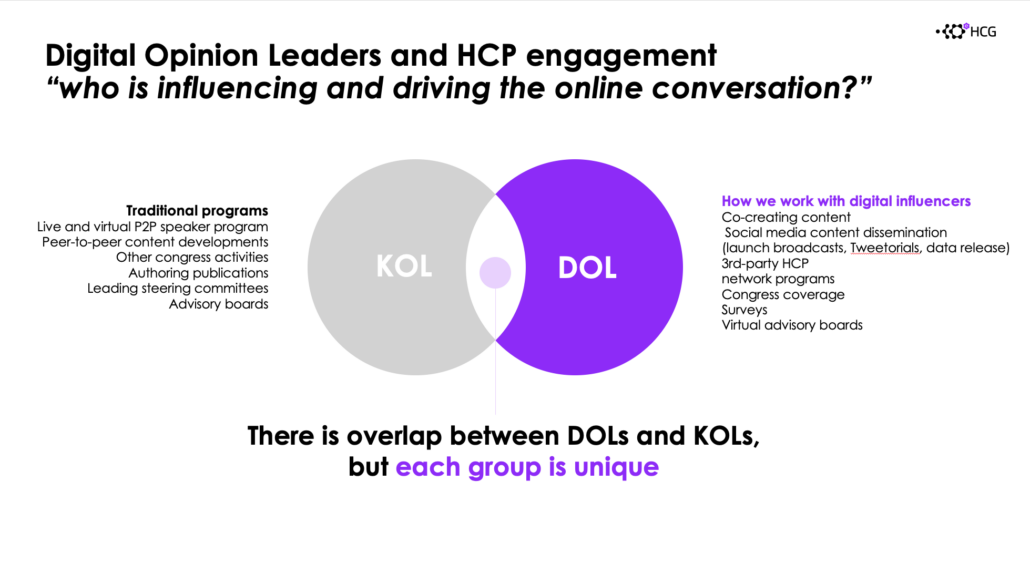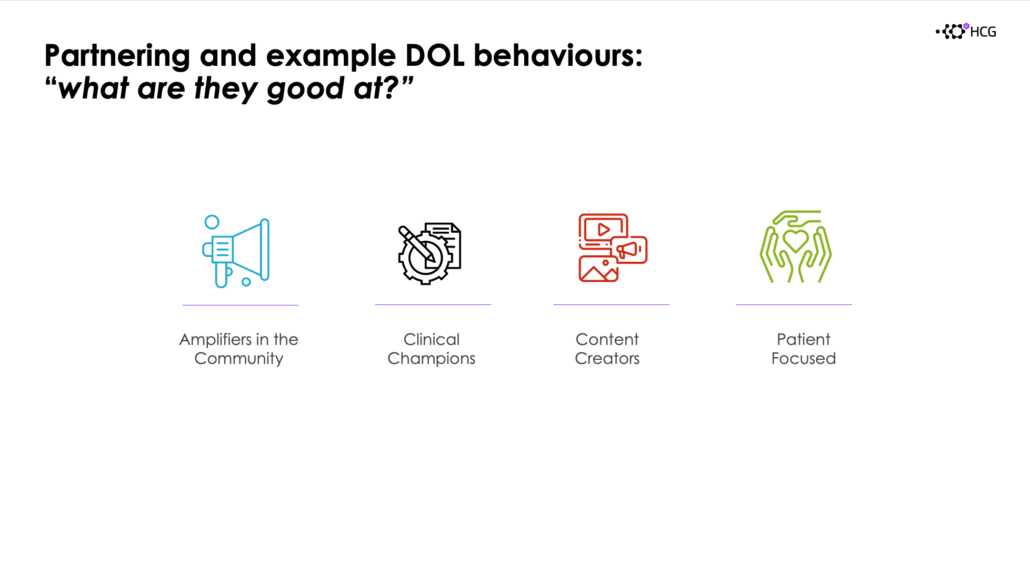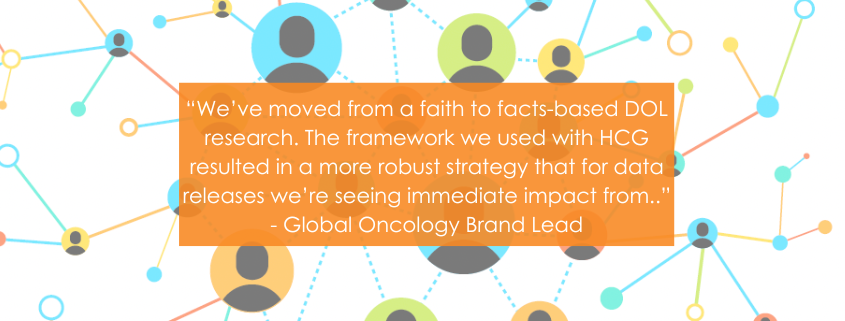The Rise of the Digital Opinion Leader
2022
Dimithri Wignarajah
Director of Digital and Communications Strategy
Healthcare Consultancy Group
Back in December 2020, we opined about the rise of Digital Opinion Leaders, a new breed of physician influencer similar to but distinct from the traditional key opinion leader that medcomms professionals have spent so much time seeking out for so long. Unlike KOLs, DOLs don’t necessarily speak to audiences at conferences, write articles in medical journals, or lead professional societies or clinical trials. Instead, they have their own audience. By using social media and other digital channels to invite their peers, patients, and others into their daily professional lives, they have built brands and large followings of their own, serving as trusted voices to their peers just as KOLs once did.
In the 18 months since, at least two variables in the DOL equation have changed. First, the two circles in the Venn diagram of KOLs and DOLs have only drawn more closely together – more, and more diverse, DOLs are out there, their peer reach is growing, and it’s getting tougher to be a traditional KOL without having a social media presence and a willingness to engage with the audience online.
“Geographic borders don’t matter here anymore…people bring themselves together virtually.”
Munir Awartani (Digital Strategist -HCG)
And second, we in medcomms have gotten much more savvy about seeking out, identifying, and partnering with DOLs. So now seems like a good time to explore how the identification of and partnership with DOLs has matured over the past year and a half.
The art of DOL identification is becoming more scientific
The keyway in which DOL identification has “grown up” of late is that it’s no longer a matter of human judgment alone. At HCG we use platforms for tracking and validating potential DOLs that monitor a variety of relevant data and factors to generate profiles and maps that measure influence – and we have good reason to believe that many of our competitors are doing the same. To build that influence profile, our platform continually asks and finds answers to a long list of questions …
Quantitative measures
- How much Twitter activity is the DOL producing, and how many followers do they have? (Twitter is the social media platform of choice for HCPs).
- Is the DOL active on other platforms, Instagram, TikTok, LinkedIn? How many likes, views, connections do they have?
- What percentage of the DOL’s social media followers are other HCPs? How active are those HCPs in communicating treatment-related material to their peers?
Qualitative measures
- To what degree is the DOL’s Twitter activity focused on treatment-related advances, presentations, institutions, etc.?
- Is the DOL an active content creator? Do they create new content and post videos on YouTube?
- Is the DOL a member of Doximity or Sermo?
- What is the quality of the content and audience engagement the DOL is producing?
Our monitoring and analysts add all this together to create an influence score ranging from 1 to 100 – anyone with a score of at least 30 has potential as a DOL (a score of 100 would be the Kim Kardashian of the HCP world!); compiling the information along with other key numbers and qualifications, building something rather like baseball cards for the stars of HCP digital influence. With those we can create and visualize how DOLs interact through maps of influence – how one HCP’s content touches another who touches another, Six Degrees of Kevin Bacon in multiple dimensions. So a user can see how content produced and posted by a prominent DOL propagates through their network of contacts – and how content created in partnership with that DOL might do the same. The bottom line of all this is that the search for suitable DOLs can be done with far greater rigor and in far less time than just 18 months ago, and the outcome of that search provides far more useful information.
Next step: Partnership
Of course, finding DOLs is only one part of the equation. The next part is what to do when you find them, how to engage and partner and create with them. To this end, all the detail we compile offers better and more efficient ways to pursue the key goal that hasn’t changed in 18 months, or ever, when building these sorts of external relationships: authenticity. DOL partnerships are at their most valuable when the HCP’s voice doesn’t change – after all, it’s that voice that got them their audience in the first place. If you are going to be on the other side of that relationship, think of yourself as no more than an amplifier and adviser and supporter. Otherwise it’s just a restaging of, “I Love You, You’re Perfect, Now Change.” So when digging into all those potential DOL profiles to find your special someone(s), seek out those who are already doing more or less what you want done, and then help them keep doing it.
And strike a balance. In our own experience we’ve encountered roughly four flavors of DOLs. Some are amplifiers in the community, broadcasting important news in their specialty to their followers. Some are clinical champions, keeping up on the latest research and sharing their insights. Some are content creators, posting self-created blogs or podcasts or videos. And some are patient-focused, providing a view into their day to day interactions with the folks whose lives are actually at stake. Some DOLs might fit into more than one of those flavors, or might change flavors over time. But each flavor provides a unique communication style that will appeal to a certain part of your audience, and so a wise medcomms team should be sure that all flavors are represented and balanced in their pot of DOL relationships. This is where those maps of influence can come in handy; one can quickly see how the five or ten or fifteen key DOLs in a particular space connect with and interact with and influence each other and how each one’s unique content style and voice weaves into that of the others. Seeing all those flavors and connections and degrees of influence and capabilities from above, well, that is the beginning of a relationship strategy, a path to balancing all while finding the greatest value in each.
What is a DOL worth? How much do you pay someone for a bit of cocreated content or a Twitter livestream? That question was difficult to answer 18 months ago, but given our greatly increased degree of experience and data maturity, it’s not so difficult now. Given that we can see quickly and to a high degree of accuracy what each DOL’s reach and estimate their impact, what sort of content they create, how regularly, and on and on, and given that we’ve actually been building and learning the benefit of those relationships, we’ve been able to develop an understanding of what fair market value for engaging with DOLs looks like. Over many years of interacting with KOLs most pharma companies and medcomms teams have developed rough guidelines for how much someone might be compensated for a particular speaking engagement at a particular location for a particular audience, but those guidelines don’t really apply to social engagements. Over time, though, we’ve been able to create our own guidelines based on relationships we’ve built with DOLs, content and events we’ve produced with them, and outcomes we’ve been able to measure from the experience.
It may sound odd to say this after all the discussion of the digital tools we’ve been using to find and measure the influence of DOLs … but at the end of the day, those tools are only as good as the analysts who develop, tweak, and monitor them. Characteristics like scientific credibility, quality of content, and social value are not axiomatic values. Real people with real healthcare and social media experience and savvy have to determine how to measure and quantify variables like that, and they have to constantly adjust them based on the changing climate of the marketplace. The tools we’ve developed save an enormous amount of time and show us clear pictures of HCP peer influence that we couldn’t have imagined 18 months ago. But they are still just tools. Humans will always be the ones deciding what the tools should measure and how to tease value from the results.
So where will we be in another 18 months, at the end of 2023? Right now the industry’s actual engagement with DOLs is still limited. We have a growing sense who the key voices are, we can see how they influence their audiences and each other, but we as an industry have barely scratched the surface of what partnership strategy can look like or the many ways we could support their abilities and interests in mutually beneficial ways. Not all MLR departments are even comfortable yet with the idea of social media-based content development relationships with HCPs – though, in our experience, they are getting a lot more comfortable as they are able to see the picture that a map of influence or a history of a DOL’s online activities can paint for them. These next 18 months are our opportunity as an industry to learn together with DOLs and grow comfortable with each other as we figure out how best to engage. And as at the beginning of many adventures, we’re excited to do it.
Contact Us
Email Dimithri Wignarajah, Director of Digital and Communication Strategy at [email protected]
Or Visit https://www.hcg-int.com/ for more information.






